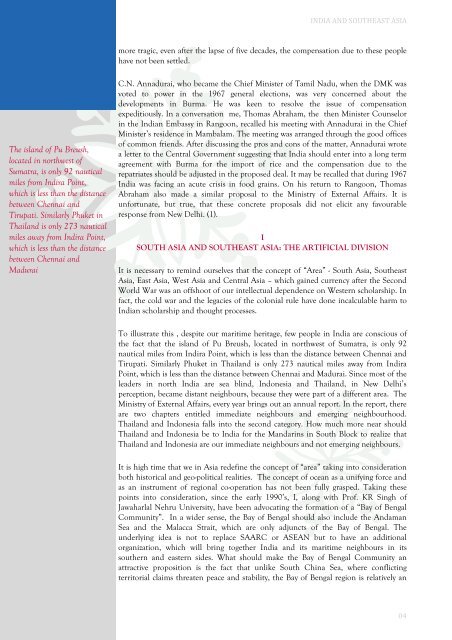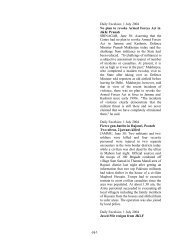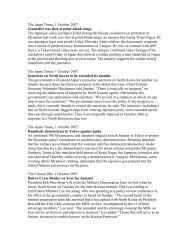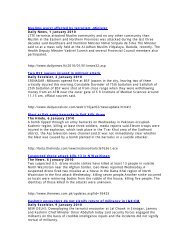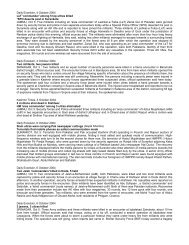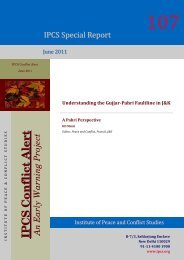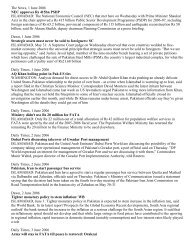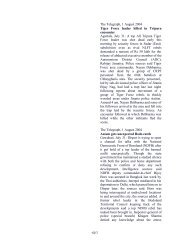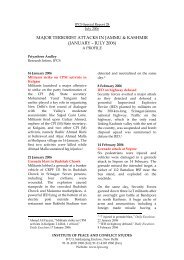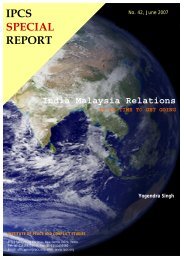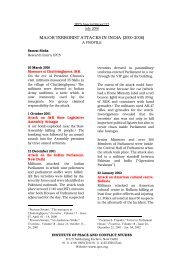India and Southeast Asia: A Personal Narrative from Chennai
India and Southeast Asia: A Personal Narrative from Chennai
India and Southeast Asia: A Personal Narrative from Chennai
You also want an ePaper? Increase the reach of your titles
YUMPU automatically turns print PDFs into web optimized ePapers that Google loves.
INDIA AND SOUTHEAST ASIA<br />
more tragic, even after the lapse of five decades, the compensation due to these people<br />
have not been settled.<br />
The isl<strong>and</strong> of Pu Breush,<br />
located in northwest of<br />
Sumatra, is only 92 nautical<br />
miles <strong>from</strong> Indira Point,<br />
which is less than the distance<br />
between <strong>Chennai</strong> <strong>and</strong><br />
Tirupati. Similarly Phuket in<br />
Thail<strong>and</strong> is only 273 nautical<br />
miles away <strong>from</strong> Indira Point,<br />
which is less than the distance<br />
between <strong>Chennai</strong> <strong>and</strong><br />
Madurai<br />
C.N. Annadurai, who became the Chief Minister of Tamil Nadu, when the DMK was<br />
voted to power in the 1967 general elections, was very concerned about the<br />
developments in Burma. He was keen to resolve the issue of compensation<br />
expeditiously. In a conversation me, Thomas Abraham, the then Minister Counselor<br />
in the <strong>India</strong>n Embassy in Rangoon, recalled his meeting with Annadurai in the Chief<br />
Minister’s residence in Mambalam. The meeting was arranged through the good offices<br />
of common friends. After discussing the pros <strong>and</strong> cons of the matter, Annadurai wrote<br />
a letter to the Central Government suggesting that <strong>India</strong> should enter into a long term<br />
agreement with Burma for the import of rice <strong>and</strong> the compensation due to the<br />
repatriates should be adjusted in the proposed deal. It may be recalled that during 1967<br />
<strong>India</strong> was facing an acute crisis in food grains. On his return to Rangoon, Thomas<br />
Abraham also made a similar proposal to the Ministry of External Affairs. It is<br />
unfortunate, but true, that these concrete proposals did not elicit any favourable<br />
response <strong>from</strong> New Delhi. (1).<br />
I<br />
SOUTH ASIA AND SOUTHEAST ASIA: THE ARTIFICIAL DIVISION<br />
It is necessary to remind ourselves that the concept of “Area” - South <strong>Asia</strong>, <strong>Southeast</strong><br />
<strong>Asia</strong>, East <strong>Asia</strong>, West <strong>Asia</strong> <strong>and</strong> Central <strong>Asia</strong> – which gained currency after the Second<br />
World War was an offshoot of our intellectual dependence on Western scholarship. In<br />
fact, the cold war <strong>and</strong> the legacies of the colonial rule have done incalculable harm to<br />
<strong>India</strong>n scholarship <strong>and</strong> thought processes.<br />
To illustrate this , despite our maritime heritage, few people in <strong>India</strong> are conscious of<br />
the fact that the isl<strong>and</strong> of Pu Breush, located in northwest of Sumatra, is only 92<br />
nautical miles <strong>from</strong> Indira Point, which is less than the distance between <strong>Chennai</strong> <strong>and</strong><br />
Tirupati. Similarly Phuket in Thail<strong>and</strong> is only 273 nautical miles away <strong>from</strong> Indira<br />
Point, which is less than the distance between <strong>Chennai</strong> <strong>and</strong> Madurai. Since most of the<br />
leaders in north <strong>India</strong> are sea blind, Indonesia <strong>and</strong> Thail<strong>and</strong>, in New Delhi’s<br />
perception, became distant neighbours, because they were part of a different area. The<br />
Ministry of External Affairs, every year brings out an annual report. In the report, there<br />
are two chapters entitled immediate neighbours <strong>and</strong> emerging neighbourhood.<br />
Thail<strong>and</strong> <strong>and</strong> Indonesia falls into the second category. How much more near should<br />
Thail<strong>and</strong> <strong>and</strong> Indonesia be to <strong>India</strong> for the M<strong>and</strong>arins in South Block to realize that<br />
Thail<strong>and</strong> <strong>and</strong> Indonesia are our immediate neighbours <strong>and</strong> not emerging neighbours.<br />
It is high time that we in <strong>Asia</strong> redefine the concept of “area” taking into consideration<br />
both historical <strong>and</strong> geo-political realities. The concept of ocean as a unifying force <strong>and</strong><br />
as an instrument of regional co-operation has not been fully grasped. Taking these<br />
points into consideration, since the early 1990’s, I, along with Prof. KR Singh of<br />
Jawaharlal Nehru University, have been advocating the formation of a “Bay of Bengal<br />
Community”. In a wider sense, the Bay of Bengal should also include the Andaman<br />
Sea <strong>and</strong> the Malacca Strait, which are only adjuncts of the Bay of Bengal. The<br />
underlying idea is not to replace SAARC or ASEAN but to have an additional<br />
organization, which will bring together <strong>India</strong> <strong>and</strong> its maritime neighbours in its<br />
southern <strong>and</strong> eastern sides. What should make the Bay of Bengal Community an<br />
attractive proposition is the fact that unlike South China Sea, where conflicting<br />
territorial claims threaten peace <strong>and</strong> stability, the Bay of Bengal region is relatively an<br />
04


